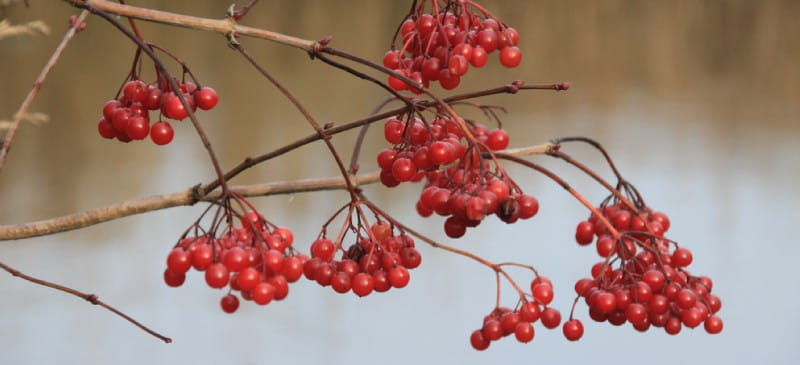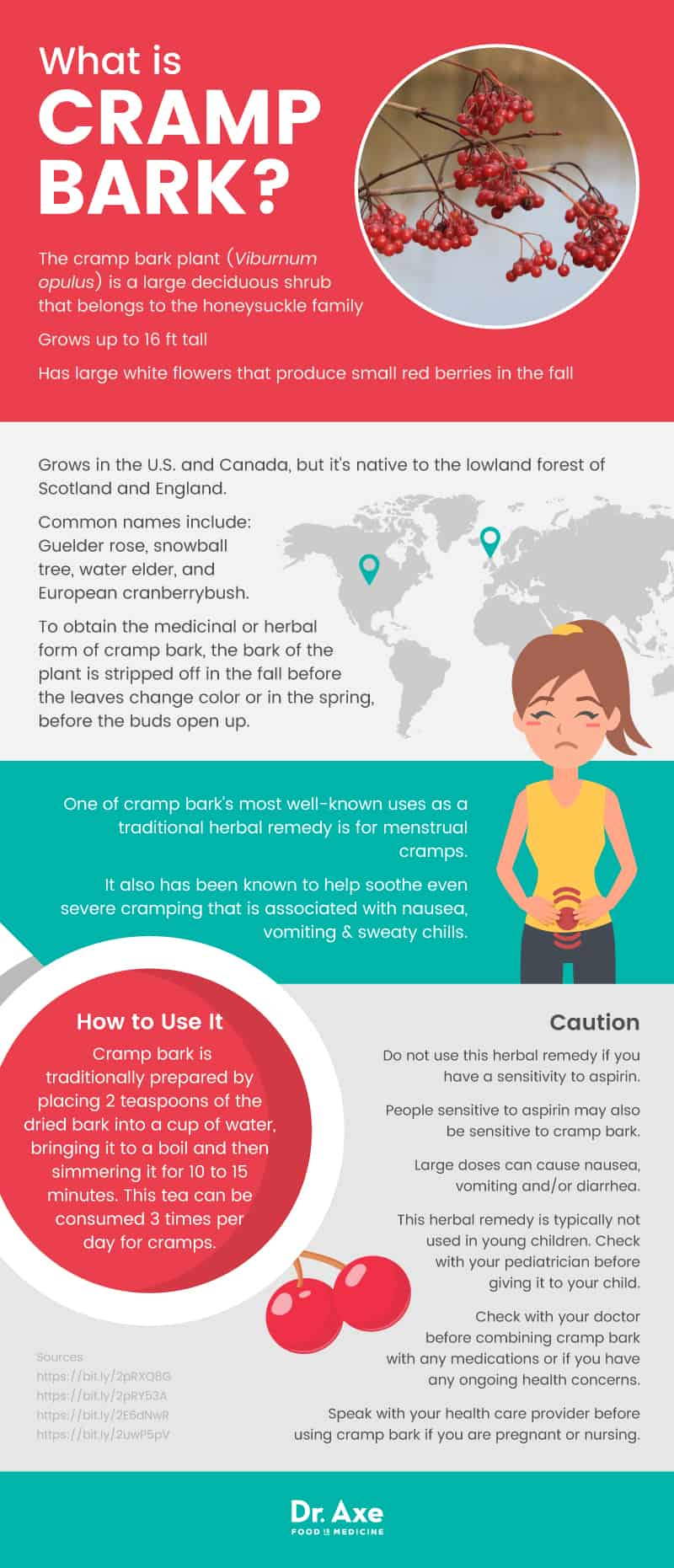Natural Pain Relief: The Power of Cramp Bark
Cramp Bark for Menstrual Relief + 4 Other Benefits
Cramp Bark

Like wintergreen, cramp bark is another herbal remedy that naturally contains a compound called methyl salicylate, which is known to have pain-relieving and anti-inflammatory effects.
As its name hints, cramp bark is known for relieving cramps, including those associated with premenstrual syndrome or PMS. It also has a long history of use in Native American herbalism, including the Penobscot tribe of Maine who used cramp bark to naturally treat gout and swollen glands. At the same time in Wisconsin, the Meskwaki tribe was using this herbal remedy for back pain, arthritis and menstrual cramps. (1)
Overall, cramp bark is said to have antispasmodic, sedative, relaxant and astringent properties. Let’s take a closer look at this intriguing herb and its many possible health benefits.
Cramp Bark Plant Origin
The cramp bark plant (Viburnum opulus) is a large deciduous shrub that belongs to the honeysuckle family. It can grow up to 16 feet tall and has large white flowers that produce small red berries in the fall. Where does cramp bark grow? Today, you can find it growing in the United States and Canada, but it’s actually native to the lowland forest of Scotland and England.
Common names for cramp bark include Guelder rose, snowball tree, water elder, and European cranberrybush. However, it is not closely related to the cranberry even though it also has red berries. (2)
To obtain the medicinal or herbal form of cramp bark, the bark of the plant is stripped off in the fall before the leaves change color or in the spring, before the buds open up. The bark contains many natural chemical plant compounds known to have positive health effects including: catechins and epicatechin; ellagic, caffeic, chlorogenic, neochlorogenic, p-coumaric, ferulic, gallic, protocatechuic, homogentisic and syringic acids; and flavonoids like astragalin, paeonoside. (3)
It’s important not to confuse cramp bark and black haw (Vibernum prunifolium). Confusion sometimes occurs because they are plant cousins and share some benefits. What is black haw used for? Like cramp bark, it is known to relieve menstrual cramps, but they are definitely two totally different plants. (4)
5 Health Benefits of Cramp Bark
What are the benefits of cramp bark? Here are some of the top ways it has been known to improve health:
1. PMS/Menstrual Cramps
Research from in vitro studies reveals that cramp bark can block the spasms of smooth muscle. (5) So it’s not surprising that one of cramp bark’s most well-known uses as a traditional herbal remedy is for menstrual cramps that can accompany PMS. It has been known to help soothe even severe cramping that is associated with nausea, vomiting, and sweaty chills.
Cramp bark is traditionally prepared by placing 2 teaspoons of the dried bark into a cup of water, bringing it to a boil and then simmering it for 10 to 15 minutes. This tea can be consumed three times per day for cramps. Another option is four to eight milliliters of tincture three times per day. (6)
2. Endometriosis
Endometriosis is a medical disorder in which the tissue that normally lines the inside of the uterus grows outside the uterus. The fruits of Viburnum opulus have been used to treat gynecological disorders, including dysmenorrhea (painful periods) as well as ovarian cysts.
A study published in the Journal of Ethnopharmocology in 2016 wanted to see if cramp bark could also improve endometriosis. In an animal model study, endometriosis was surgically induced in subjects and then cramp bark fruit extracts were administered for four days.
The subjects treated with the extracts of Viburnum opulus berries showed significant improvement in their endometriosis compared to the control group. The study concludes that Viburnum opulus‘s chlorogenic acid content, along with its other phenolic compounds, are likely responsible for its positive effects on endometriosis. (7)
3. Miscarriage
According to experts in the field, cramp bark has long been used as a spasmolytic (or antispasmodic) during pregnancy, particularly in miscarriage prevention. This use as an herbal remedy in pregnancy is said to go back to Native American tribes.
Cramp bark is known to be a top pick by herbalists in the United Kingdom for preventing miscarriage. Several active substances in Viburnum opulus including scopoletin and aesculetin have been labeled as having antispasmodic effects on the uterus. (8)
Midwives sometimes choose cramp bark for a threatened miscarriage, as well as early labor, during actual labor, and for after-labor cramping. While this may sound strange, herbs are known for sometimes having opposite effects on the body depending on the quantity used, when and how they are used and whether or not an herb is used alone or in combination with other herbs.

4. Muscle Relaxant
Cramp bark has a lengthy history as a natural muscle relaxant. (9) As I mentioned earlier, it is known to relieve menstrual cramping due to its ability to stop smooth muscle spasms. For this reason, it’s also known to help relieve muscle spasms and aches throughout the body, such as in the back or legs, whether related to PMS or physical exertion. (10)
If you’re struggling with muscle spasms, aches or pain, this herbal remedy may be a safer alternative to NSAIDs, which have been shown to have numerous dangerous side effects. In fact, all prescription NSAIDs have a warning that they can increase the risk of having a heart attack, stroke and stomach bleeding. Other common side effects of NSAIDs include stomach pain, leg swelling, headaches, dizziness, high blood pressure, and kidney issues. (11)
5. Possible Anticancer Effects
A study published in 2018 in the Journal of Cancer Research and Therapeutics points towards possible anti-tumor and anticancer effects of Viburnum opulus. Using an animal model, researchers demonstrated how extracts from gilaburu juice (juice made from the berries of the cramp bark plant) displayed in vivo antitumoral activity. (12)
Another study published in 2013, used an animal model to evaluate possible positive effects on colon cancer in particular. Overall, they found that the groups of animal subjects who had 1,2-dimethylhydrazine (DMH)-induced colon cancer who were treated with gilaburu juice for 30 weeks experienced a reduction in mean total number of tumor lesions. The researchers conclude that “gilaburu juice may be useful for the prevention of colon cancer at the initiation stage.” (13)
History & Interesting Facts
The reason why the cramp bark plant is also known as Guelder rose has a little bit of story to it. Since it is said to have first been formally cultivated in the Dutch city of Gueldersland, this alternative name is in honor of this city.
Another interesting fact about cramp bark is that it is one of the national symbols of Ukraine where it is featured in art, songs and folklore. In Ukraine, it’s known as Kalyna. This alternative name comes from the legend of Kalyna, who was believed to be a goddess during the birth of the universe. To this day, the “Kalyna” plant is a central aspect of Ukrainian culture.
While the bark is used medicinally, the dried berries are employed in the creation of dark ink and dye. The berries are also sometimes used to make jelly and preserves. (14)
How to Find and Use Cramp Bark
If you’re wondering where to buy cramp bark, you can typically find the dried parts of the plant in bulk or as cramp bark capsules, tincture or tea bags in health stores or through online retailers.
There is currently no standard dosing for cramp bark, but one recommendation for health concerns such as cramping or muscle spasms is one cup of tea made from 2 teaspoons of the dried bark or four to eight milliliters of tincture three times per day. (15)
The appropriate dosage depends on a few factors, including the user’s age and health status. If you have any questions about use and dosage, always consult a health care professional or qualified herbalist. It’s also important to read cramp bark supplement labels closely. (16)
You can use the dried herb to make a homemade cramp bark tincture recipe. In some stores around the world and online, you can also find juice made from the berries of Viburnum opulus called gilaburu juice.
If you’re looking to grow a cramp bark plant, you may be able to find it at your local garden center. These plants are known to thrive in damp, woody climates.
Possible Side Effects and Caution
Cramp bark typically doesn’t cause unwanted side effects in normal doses. However, do not use this herbal remedy if you have a sensitivity to aspirin. People sensitive to aspirin may also be sensitive to cramp bark.
Large doses of cramp bark can cause nausea, vomiting and/or diarrhea. (17)
This herbal remedy is typically not used in young children. Check with your pediatrician before using with your child.
Check with your doctor before combining cramp bark with any medications. Also, check with your doctor before using it if you have any ongoing health concerns.
Speak with your health care provider before using cramp bark if you are pregnant or nursing.
Cramp Bark Key Points
- Cramp bark has a lengthy history of use for women’s health issues, including menstrual cramps, as well as endometriosis and miscarriage.
- It’s also an herbal remedy for muscle pain and spasms and pain throughout the body.
- It contains many chemical components, which lead it to having antispasmodic, sedative, relaxant and astringent properties.
- So far, research using animal models demonstrates that juice and extracts from the berries of the plant show promise for having anti-tumor and anti-cancer properties.
- Dried cramp bark can be used to make a tea or a tincture. You can also buy tea bags, pre-made tincture or capsules.





Leave a comment